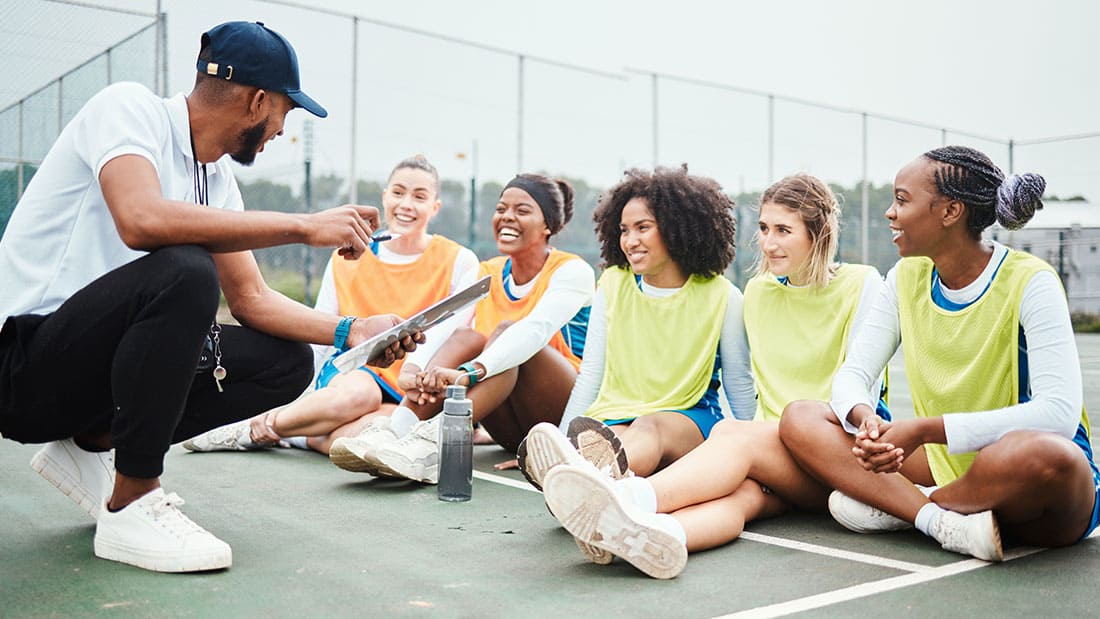The Powerful Impact of Positive Coaching Techniques

The Powerful Impact of Positive Coaching Techniques
As a coach, you want your athletes to learn, improve, and succeed. But for this to happen, they need to feel supported and encouraged. Whether your team wins the game or not, your athletes need to know that you’ll be there waiting for them with a high five on the sidelines.
Incorporating positive techniques into coaching is a well-documented way of building self-esteem and self-confidence in athletes while also increasing their love of the sport. Yet, many coaches don’t realize the power that positive coaching techniques can have on an individual athlete or a team.
Instead, unfavorable coaching habits—such as the overuse of negative criticism or placing a significant amount of pressure on a team or athlete to win—create an
environment where athletes struggle to succeed or have fun. Because of this, many kids choose to walk away, leaving the game they once loved because it’s no longer supportive or enjoyable.
In fact, research shows the result of these negative sport environments is an estimated 70%-80% of youth exiting sport by age 15.
But as a coach, you can help change this statistic. By adding a few simple methods to your coaching toolkit, you can create a sport setting that builds your athletes up, so they feel valued and respected—and enjoy the game longer.
Here are five positive coaching techniques you can use:
1) Promote having fun over winning.
While winning can be exciting, it’s important to encourage a love of the playing process by promoting a sport environment built on friendship, support, and team camaraderie.
2) Always give praise before criticism.
When giving feedback to an athlete or team, always start by saying something they’re doing well. Then, offer a gentle critique of what they could improve on. Finish with another positive piece of feedback.
3) Model appropriate and respectful behavior.
No matter who you’re interacting with—athlete, parent, official, or another coach—always treat them with respect and kindness. Modeling appropriate behavior shows your athletes how to engage with those around them in a respectful way.
4) Be consistent.
Remain consistent in how you communicate with athletes and how you hold everyone accountable to team values, expectations, and policies.
5) Pay close attention to marginalized groups.
Be aware that athletes in marginalized groups—such as athletes with disabilities or athletes of color—may be at a higher risk of experiencing bullying or harassment.
Resources for Coaches
Coaches lead athletes, which is why it’s important to lead with positivity and kindness. Offering constructive feedback, reminding athletes of how far they’ve come, and pointing out positive plays or improvements even after a losing game or a missed shot go a long way in building a supportive team culture that makes athletes feel like they belong.
For more tips on how you can create a thriving sport environment for your athletes, explore the U.S. Center for SafeSport’s Ways to Create a Positive Sport Environment handout. To learn more about how you can help create abuse-free sport settings for all participants, visit uscenterforsafesport.org.
The U.S. Center for SafeSport is a nonprofit organization created to respond to and prevent sexual, physical, and emotional abuse in the U.S. Olympic and Paralympic Movement, from which it is independent. The Center also trains and educates people and organizations at all levels to support sport and recreation settings across America that protect athlete well-being.
RECOMMENDED FOR YOU
The Powerful Impact of Positive Coaching Techniques

The Powerful Impact of Positive Coaching Techniques
As a coach, you want your athletes to learn, improve, and succeed. But for this to happen, they need to feel supported and encouraged. Whether your team wins the game or not, your athletes need to know that you’ll be there waiting for them with a high five on the sidelines.
Incorporating positive techniques into coaching is a well-documented way of building self-esteem and self-confidence in athletes while also increasing their love of the sport. Yet, many coaches don’t realize the power that positive coaching techniques can have on an individual athlete or a team.
Instead, unfavorable coaching habits—such as the overuse of negative criticism or placing a significant amount of pressure on a team or athlete to win—create an
environment where athletes struggle to succeed or have fun. Because of this, many kids choose to walk away, leaving the game they once loved because it’s no longer supportive or enjoyable.
In fact, research shows the result of these negative sport environments is an estimated 70%-80% of youth exiting sport by age 15.
But as a coach, you can help change this statistic. By adding a few simple methods to your coaching toolkit, you can create a sport setting that builds your athletes up, so they feel valued and respected—and enjoy the game longer.
Here are five positive coaching techniques you can use:
1) Promote having fun over winning.
While winning can be exciting, it’s important to encourage a love of the playing process by promoting a sport environment built on friendship, support, and team camaraderie.
2) Always give praise before criticism.
When giving feedback to an athlete or team, always start by saying something they’re doing well. Then, offer a gentle critique of what they could improve on. Finish with another positive piece of feedback.
3) Model appropriate and respectful behavior.
No matter who you’re interacting with—athlete, parent, official, or another coach—always treat them with respect and kindness. Modeling appropriate behavior shows your athletes how to engage with those around them in a respectful way.
4) Be consistent.
Remain consistent in how you communicate with athletes and how you hold everyone accountable to team values, expectations, and policies.
5) Pay close attention to marginalized groups.
Be aware that athletes in marginalized groups—such as athletes with disabilities or athletes of color—may be at a higher risk of experiencing bullying or harassment.
Resources for Coaches
Coaches lead athletes, which is why it’s important to lead with positivity and kindness. Offering constructive feedback, reminding athletes of how far they’ve come, and pointing out positive plays or improvements even after a losing game or a missed shot go a long way in building a supportive team culture that makes athletes feel like they belong.
For more tips on how you can create a thriving sport environment for your athletes, explore the U.S. Center for SafeSport’s Ways to Create a Positive Sport Environment handout. To learn more about how you can help create abuse-free sport settings for all participants, visit uscenterforsafesport.org.
The U.S. Center for SafeSport is a nonprofit organization created to respond to and prevent sexual, physical, and emotional abuse in the U.S. Olympic and Paralympic Movement, from which it is independent. The Center also trains and educates people and organizations at all levels to support sport and recreation settings across America that protect athlete well-being.











